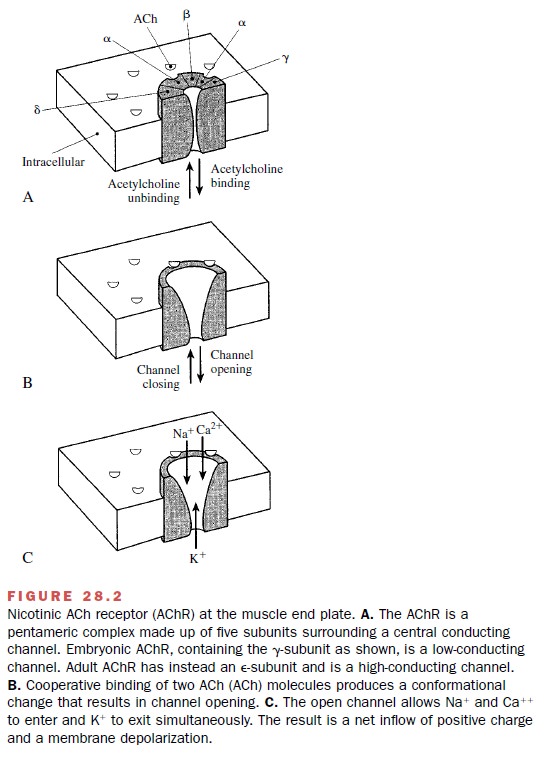Chapter: Modern Pharmacology with Clinical Applications: Local Anesthetics
Depression of Postjunctional Response to Acetylcholine
DEPRESSION OF
POSTJUNCTIONAL RESPONSE TO ACETYLCHOLINE
Neurotoxins
α-Bungarotoxin (α-BTX), isolated from snake
venom, is a protein that binds selectively and irreversibly to the AChR of
muscle. Because binding of the toxin is irre-versible, recovery from α-BTX block indicates
synthesis and insertion of new AChR into the membrane. Studies using -BTX show
that the AChR is a glycoprotein con-sisting of five polypeptide subunits ( α, β, γ, δ, and ε). The complex is a cylindrical unit about 8 nm in diameter that
spans the plasma membrane (Fig. 28.2).

Histrionicotoxin, obtained
from a Panamanian frog, is a toxin that attaches to a high-affinity site within
the pore of the AChR complex and results in muscular blockade. Agents that have
a similar effect include local anesthetics, barbiturates, and phencyclidine.
They re-duce the flow of ions and shorten the duration of time the channel is
open.
The AChR in muscle is
distinct from the AChRs found in the central and autonomic nervous systems
(neuronal AChRs). Although both are activated by nicotine, each is blocked by a
different antagonist (e.g., α-BTX vs.κ -BTX).
Myasthenia Gravis
The “acquired” form of
myasthenia gravis (MG) is an autoimmune disease with an incidence approaching 1
in 10,000. It involves an antibody response against part of the -subunit of the
AChR in muscle. This leads to degradation of AChRs, reduction of synaptic
infoldings, and weakness due to diminished postjunctional re-sponse. Because
anti-AChR antibodies are found in nearly 90% of MG patients, serum testing can
serve as a diagnostic tool. MG is often found associated with ab-normalities of
the thymus, which contains a protein that is immunologically related to muscle
AChR.
Standard treatment consists of anti-AChE agents such as
pyridostigmine, whose effect is long-lasting and pre-dictable. A short acting anti-AchE,
such as edrophonium, can be used to
differentiate between a myasthenic crisis
(insufficient treatment) and a cholinergic
crisis (overtreat-ment with anti-AChEs).Thymectomy is a good option for
patients under 50 years of age. Immunosuppressive agents, such as corticosteroids
and possibly azathioprine or cyclosporine A, are also effective. Plasmapheresis
is beneficial, but the effect is transient.
Related Topics